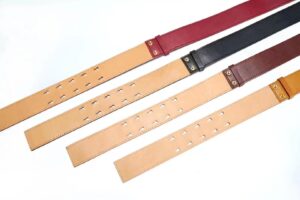Vegetable Tanned Leather:
Advantages of Vegetable Tanned Leather
Vegetable tanned leather, also known as veg-tan leather, is a traditional and environmentally friendly method of tanning leather using natural tannins derived from plants. This ancient technique offers a range of benefits and challenges that appeal to different users and applications. Below, we explore the advantages and disadvantages of vegetable tanned leather.
1. Natural and Eco-Friendly: Vegetable tanned leather is made using natural tannins from plants, making it a more environmentally friendly alternative to chemically treated leathers. It is biodegradable and has a low impact on the environment.
2. Durability and Longevity: Known for its strength and durability, vegetable tanned leather can last for many years with proper care. It ages gracefully, developing a rich patina over time that enhances its appearance.
3. Unique Aesthetics: Each piece of vegetable tanned leather develops a unique patina, resulting in a one-of-a-kind product with character. The natural process leads to variations in shade and color, adding to its charm.
4. Breathability: Products made from vegetable tanned leather are extremely breathable, making them comfortable to wear.
5.Traditional Craft: Supporting the production of vegetable tanned leather helps to keep traditional leather crafting techniques alive, providing employment to craftsmen who have developed these skills over generations.
Disadvantages of Vegetable Tanned Leather
1. High Cost: Due to the slower and more labor-intensive tanning process, vegetable tanned leather is typically more expensive than other types of leather.
2. Time-Consuming Process: The tanning process for vegetable tanned leather can take several weeks, making it less suitable for mass production and contributing to its higher cost.
3. Limited Color Range: Vegetable tanned leather is typically only available in natural shades, such as brown and black, due to the tannins used in the process. This limits the color options compared to chemically treated leathers.
4. Water Resistance: Vegetable tanned leather is not inherently waterproof and can be easily stained with water or in the presence of iron if not handled with care.
5. Stiffness: Initially, vegetable tanned leather can feel stiff, although with extended use, the texture softens and becomes more comfortable over time.




